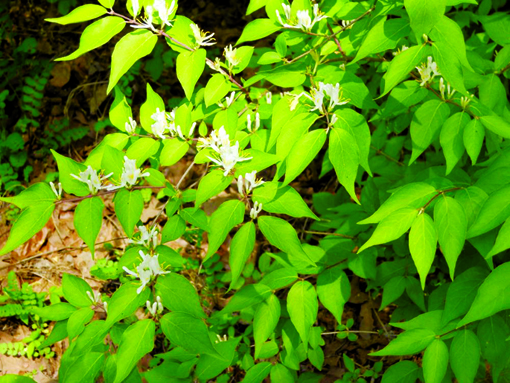Dreaded Bush Honeysuckle

If I could drive down my lane with my eyes closed, I would. As much as I love anything green and growing, I have a hard time looking at all of the invasive Bush honeysuckle currently in full bloom.
It’s the proverbial dilemma of beauty versus damage to native natural communities. A friend of mine has carefully pruned Bush Honeysuckle shrubs all around her property, only to wonder now why nothing is growing under them but she won’t believe it’s the lovely bush honeysuckle.
Bush honeysuckle produces a chemical that inhibits everything that grows under and within close proximity to its roots. A native of Asia, Bush honeysuckle produces leaves earlier in the spring and holds on to them late in autumn, giving it a decided competitive advantage over many native plants.
In addition, the Bush Honeysuckle entices birds with their bright red berries, ensuring that their seeds are widely scattered even though the berries themselves don’t offer birds much in terms of food value.
Some communities now sponsor Bush honeysuckle removal days, mobilizing volunteers to yank, pull, cut – whatever it takes – to remove the plants.
I started my own battle against Bush honeysuckle several years ago when a former office colleague came over early spring and helped me cut down the largest bushes. As he cut the larger branches I yanked at the 1-3 year starts, quickly creating a huge pile of greenery that overwhelmed my three empty composters.
I continue the battle, waiting for days after a good rain to walk through my hillside garden and yank at all of the plant starts I can find.
For those plants that have tried to escape my attention, red yarn decorates their trunks so that they are targeted for removal once my handyman brings his chain saw over for a day. I have my own chainsaw but my brother, David, made it clear I was not to use it on my own. It’s good advice, I’ve been known to unbeknownst to myself at the time stab myself with a trowel. Or a bread knife.
Missouri Department of Conservation suggests the best time to tackle these plants is fall, when their sap is receding and one can apply any one of those site-specific weed killers. Since I have honeybees, I don’t use those products on my property, relegating me to the ongoing battle of pulling the plants as often as I can and denying them an opportunity to produce berries.
These plants grow almost everywhere: lake and stream banks, marshes, fens, sedge meadows, wet and dry prairies, savannas, floodplain and upland forests and woodlands.
A recently introduced pest, the European Honeysuckle aphid, somewhat controls flower and fruit production in some of the Bush Honeysuckles. Heavy bug infestations cause tips of branches to form “witches’ brooms” or deformed twigs, often greatly reducing fruit production. Native ladybug beetles, however, have been noted to control the aphids.
Guess this will continue to be my battle as long as I don’t drive myself off the road.
Charlotte Ekker Wiggins is a beekeeper, gardener and sometimes cook. Published by El Dorado Springs Sun once in print and online with author’s permission. Copyright 2017, all rights reserved. This column may not be reprinted, republished or otherwise distributed without author’s permission. Contact Charlotte at gardeningcharlotte@gmail.com.

DECEPTIVELY PRETTY – Bush honeysuckle has lovely honeysuckle-like flowers without a sweet fragrance on grey branches this time of year. Cut or pull them now, before they produce red berries.
 DECEPTIVELY PRETTY – Bush honeysuckle has lovely honeysuckle-like flowers without a sweet fragrance on grey branches this time of year. Cut or pull them now, before they produce red berries.
DECEPTIVELY PRETTY – Bush honeysuckle has lovely honeysuckle-like flowers without a sweet fragrance on grey branches this time of year. Cut or pull them now, before they produce red berries.



Facebook Comments